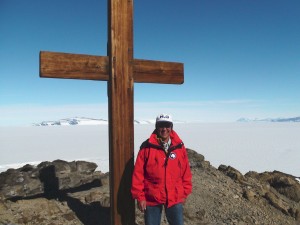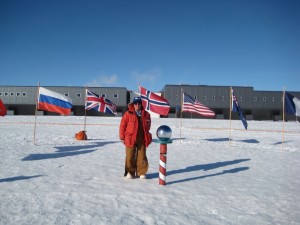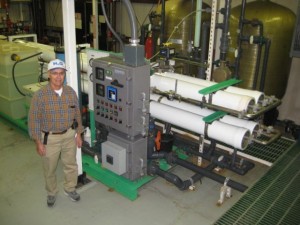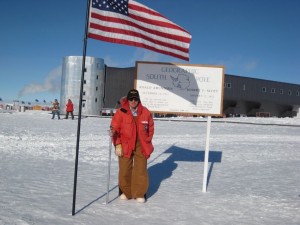Summer in Antarctica
Hi Osky people,
My name is Paul Jones and my permanent home is in Montezuma, Iowa, a close neighbor of your city. I was a teacher in Montezuma for 36 years in the same room before retirement in 1998.
This summer I was walking down our main street and bumped into a former science student Mr. Ken Allsup who now works for your paper. He asked what I was doing now that I had retired from teaching and I told him I was working in Antarctica operating the water plant there during Nov. Dec. and January. If you have forgotten your 7th grade science that is summer time there. Ken asked if I would write a short article about my situation there and here is the first and possibly the last installment. (I hope not personally as it’s such a unique opportunity to learn, so lots of questions people! – Ken)

Paul Jones at the top of Observation Hill looking at the harbor, the Cross is is memory of Rober Scott an early explorer who died trying to be the first person to South Pole. He actually was the 2nd person but died on the way back.
I do have a little connection with your city. During the summer of 2009 I worked for the Oskaloosa water plant for 12 weeks replacing an operator there on medical leave. It was sure nice to work with manager Chad Coon and your fine professional crew. By now your improved water plant is probably in full production.
Our water plant in McMurdo Station is totally different than yours or Montezuma’s. We have a reverse osmosis process that simply takes the salt from sea water. Our town of 1,200 is right at the ocean edge but it is covered with at least 12 feet of ice. We have a pump house at the ocean edge and drill a hole through the ice and bring the salt water to our plant. The RO (reverse osmosis) tubes are filled with a membrane with very small holes that will let the water through and stop the salt. With holes this small the pressure must be very high (over 600 lbs/sq. inch) to force the water molecules through the membrane. If everything works properly things go fine. Unfortunately they do not always do that. Our plant can produce approximately 80,000 gallons per day and the camp uses about 65 – 70 thousand gallons per day. — This camp is McMurdo Station and it is America’s science base here on the Continent of Antarctica.
It is a long way from Oskaloosa. I work for Raytheon, a government contractor that supplies the base. Their home office is in Denver so I go from Des Moines to Denver, spend several days there training, go from Denver to LAX and then fly the 14 hour flight from LAX to Auckland NZ. That is a tough flight. From Auckland we go right on to Christchurch NZ where we do get to spend two nights. We get our cold weather gear in Christchurch and then fly a military C-17 cargo plane to the ice as we say (actually McMurdo Station). This plane lands right on the 12 feet thick ocean ice and here we are. There are approximately 200 scientists here at McMurdo and it takes at least 4 “workers” to support one scientist. There is every kind of worker here that there is in Osky, only no teachers or police. There are no kids, so no need for teachers, and if you get into trouble here you are simply sent home. Some of the research involves atmosphere, glaciers, volcanoes, ice cores, climate, fish, and of course penguins. In the summer there is 24 hour daylight so the camp is really busy all the time. In the winter there is 24 hour darkness and most research is astronomy. NO I have never stayed the winter and have no desire to do so. McMurdo in winter will get to -60 and -70 is not uncommon. At South Pole it always hits -100 below sometime in July. That would be cold I’m sure.
The camp could really be compared to William Penn College with a major science building, utilities, maintenance facilities, dorms, dinning hall and even some class rooms. People range in age from 20 to 80; I am one of the oldest but get along fine. Approximately 35-40% is female. We are all just working together trying to get the projects accomplished. Nothing real exciting. This year in early Sept. Christchurch had been hit by a major earthquake, lots of severe damage to the lovely city. I experienced 2 aftershocks while I was there. These were just little bitty tremors but I could feel the hotel sway and it brought me out of bed that is for sure. I have never experienced an earthquake before. Not sure I want to experience it again either.
If you have any questions that you would like to ask me, send them to Ken at the paper and he could forward them to me. We have pretty good commutation to most everywhere but I work a 12 hour shift usually so really do not have much computer time available. I will sure inform Ken of any important developments. Thank you for the opportunity to share a part of my experiences with you.
See ya,
Paul Jones.



















[…] Some of you may remember Paul Jones. He a Montezuma resident that serves at the US Station in the Antarctic. You can read his previous story HERE. http://oskynews.org/?p=5762 […]